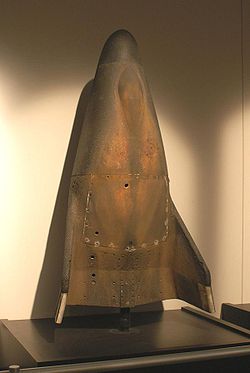Martin-Marietta X-23
| Martin-Marietta X-23 | |
|---|---|

|
|
| Type: | Experimental airplane |
| Design country: | |
| Manufacturer: |
Martin-Marietta |
| First flight: |
December 21, 1966 |
| Commissioning: |
Flight tests ended in 1967 |
| Production time: |
Was never mass-produced |
| Number of pieces: |
4th |
The Martin-Marietta X-23 was a small supporting hull - reentry aircraft , which the United States Air Force has been tested in the 1960s. The X-23 was designed primarily to study the effects of maneuvers during re-entry, including maneuvers with a deviation of up to 1143 km from the ballistic trajectory .
history
The X-23A, also known as SV-5D, was developed under the PRIME (Precision Recovery Including Maneuvering Entry) project, which in turn was part of the three-part START (Spacecraft Technology And Advanced Entry) program. In these programs, the shape of the SV-5 float was examined both at very high reentry speeds (X-23A) and at low landing speeds (X-24A). The SLV-3 Atlas, which was launched from the SLC-3E site at Vandenberg Air Force Base, was used as the launch vehicle for the tests.
construction
Each X-23 is made from a 2014-T6 titanium alloy and beryllium , stainless steel, and aluminum . The entire system was protected by a heat shield developed by Martin Marietta , which was 20 to 70 mm thick. The nose was made of a carbon - phenolic resin .
The attitude was controlled by 30 cm long lower flaps, upper flaps and oars. A nitrogen gas control system was deployed outside the Earth's atmosphere . At Mach 2 a parachute was opened to slow down the descent of the X-23. Later, a special parachute with a diameter of 16.4 m was opened, which was hauled in by a modified Lockheed C-130 .
Flight attempts
The first X-23 was launched on December 21, 1966 from Vandenberg with an Atlas rocket . During the mission, the X-23 entered low orbit . Upon returning to Earth, the first parachute opened at an altitude of 30.43 km, but the main parachute failed to open successfully, which is why the X-23 fell into the Pacific .
The second flight started on March 5, 1967 and reached a "range" (deviation from the ballistic trajectory) of 1053 km and the control at supersonic speed. Some "stringers" on the main parachute were not separated, which again prevented the X-23 from being successfully recovered.
The third and final flight of an X-23 was carried out on April 19, 1967. This time all systems worked perfectly and the X-23 could be recovered after landing. After a thorough investigation, it was determined that the X-23 would be operational again, but no further flight was made with it.
Whereabouts
The third X-23 will be on display at Wright-Patterson Air Force Base today . Nothing was known about the whereabouts of the fourth built float, which never flew.
General data
| Parameters | Data |
|---|---|
| span | 1.16 m |
| length | 2.07 m |
| height | 0.64 m |
| Takeoff weight | 405 kg |
| crew | unmanned |
| Highest speed achieved | about 16,500 mph (Mach 25) |
| Greatest height reached | about 150 km (500,000 ft) |
| Range | in tests up to 1143 km deviation from the ballistic trajectory |
See also
- BOR (space glider) - similar Soviet project
literature
- Dennis R. Jenkins, Tony Landis, Jay Miller: AMERICAN X-VEHICLES An Inventory — X-1 to X-50 , available online as a pdf file
Web links
Individual evidence
- ↑ Description on history.nasa.gov p. 30. (PDF; 1.2 MB) Retrieved on February 11, 2013 .